On p.114 of Jerrold Northrop Moore’s weighty “Edward Elgar: A Creative Life”, the author notes that Elgar’s enciphered “Liszt fragment” had been decoded (in 1977, according to Anthony Thorley whose decryption it was) to read:
Gets you to joy, and hysterious
Well… it’s certainly a claim, even if ‘hysterious’ is a made-up word found nowhere else. And one of the (cryptologically, at least) interesting aspects that link this Liszt fragment and Elgar’s Dorabella Cipher is that while both of them seem unlikely to have employed complicated cipher systems, for all of that both also seem improbably hard nuts to crack. You’d certainly need a sweet nutcracker to achieve it. [*]
I’ve discussed Elgar’s Liszt fragment before, written in the left margin of an 1885/1886 Crystal Palace Saturday Concert Programme:
The cipher on its own looks like this (sorry, but I don’t have a better scan):-
It’s not a great scan, certainly: but given that though the dash looks as though it is meant to sit at the end, and there are several half-space-sized gaps, it looks as though we might be able to transliterate this as:
ABC DECFGB HID CBJKDK
What should be immediately apparent is that there is no obvious way to convert this 3 + 6 + 3 + 6 = 18 letter cryptogram into Thorley’s 25-letter “Gets you to joy, and hysterious”, without a singularly large floor space for mental acrobatics to bounce around on. (If that’s what you want to do, feel free to go ahead.)
And yet, what we undeniably have with the Liszt fragment that we don’t seem to have with the (much later) Dorabella Cipher is context, specifically a musical context. And here I can’t help but notice not only that the Liszt ciphertext seems to have been written in sets of three or sets of six, but also that the music it sits besides also has a very strong emphasis on triplets, groups of three notes.
Moreover, the 18-letter group is written immediately beside an 18-note line of music, “No. 6 Allegretto Pastorale”. Might the first be enciphering the other in some way?
a...b...c...d...e...c...f...g...b...h...i...d...c...b...j...k...d...k...
B...G#..E...B...G#..E...B...B...E...F#..G#..C#..B...G#..F#..E...F#..G#..
I can’t see any obvious cryptographic connection myself here, but I was somewhat surprised to find that nobody had apparently suggested this at least as a reasonable possibility for the Liszt fragment, far more so than for the Dorabella Cipher. (Plenty of people [e.g. Javier Atance, etc etc] have suggested that the Dorabella Cipher might be enciphering music, but that’s another story entirely).
Something to think about, anyway. 🙂
[*] Made me laugh, anyway. 🙂

I’m with you on this one: the notation probably fits best in a musical context. I also believe this was Elgar’s shorthand music notation. I believe he was making edits to the Liszt piece while at the concert. It’s very likely he used this shorthand in the Dorabella. My guess its that it translates to a music piece meant for Dora Penny to play, a rudimentary one.Similar notations from Bach. http://www.iment.com/maida/familytree/henry/music/bachnotation.htm
Great post, as always.
Annie: thanks. The general problem with the scenario, though, is that Elgar left a huge archive of notes and papers, much of which Dora Penny was later entrusted with going through: and I don’t believe that – beyond a few tiny examples, such as the Liszt fragment – she found anything else even remotely similar. So if it was Elgar’s musical shorthand, it wasn’t something that he seems to have relied heavily upon.
It’s easy to speculate that the eight directions correspond to the 7-note do-re-mi-fa-sol-la-ti cycle + a rest (or perhaps Elgar had his own private do-ra-pe-ny-se-xy-la-dy sol-fa scale, who can tell?), and that the number of loops in each symbol corresponds to length or octave or staccato-ness or some combination. But for the Dorabella ciphertext this has been raked over countless times by eager crypto-musicologists, without yet finding anything musically plausible.
For what it’s worth, I suspect that the truth lies somewhere between all these things simultaneously: that Elgar used the eight E-shapes as shorthand for the 7 do-re-mi words plus one for a rest, but not in a straightforward clockwise or anticlockwise order (i.e. not N, NE, E, SE, S, etc). When he was idly writing down some melody beside the Liszt fragment while (almost certainly) at a concert, he wouldn’t have had anything so complicated as a cipher key with him – so if this is right, the mapping must have been visually obvious, direct and unforgettable.
Annie’s site – now I think I know where Nick picks up his book money. 🙂
Nick – Interesting points. I wonder if placed in the hands of another composer, they’d see something obvious. No matter how many times I look at it, the Dorabella Cipher always reminds me of sheet music…
Diane – 🙂
Hello Nick!
I don’t know how I managed to overlook this article 10 years ago. Reading it (again) today, as well as Annie’s comment, I’m convinced it’s a composer’s notes.
As for Dora Penny, we’ll never know why she pretended not to recognize the meaning of the note.